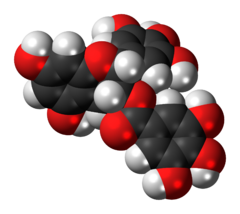Epigallocatechin-3-gallate
 |
|
 |
|
| Names | |
|---|---|
|
IUPAC name
[(2R,3R)-5,7-dihydroxy-2-(3,4,5-trihydroxyphenyl)chroman-3-yl] 3,4,5-trihydroxybenzoate
|
|
|
Preferred IUPAC name
(2R,3R)-5,7-dihydroxy-2-(3,4,5-trihydroxyphenyl)-3,4-dihydro-2H-1-benzopyran-3-yl 3,4,5-trihydroxybenzoate
|
|
| Other names
(-)-Epigallocatechin gallate
|
|
| Identifiers | |
|
3D model (JSmol)
|
|
| ChEBI | |
| ChemSpider | |
| ECHA InfoCard | 100.111.017 |
| MeSH | Epigallocatechin+gallate |
|
PubChem CID
|
|
|
|
|
|
| Properties | |
| C22H18O11 | |
| Molar mass | 458.372 g/mol |
| Appearance | |
| soluble (33.3-100 g/L) | |
| Solubility | soluble in ethanol, DMSO, dimethyl formamide at about 20 g/l |
|
Except where otherwise noted, data are given for materials in their standard state (at 25 °C [77 °F], 100 kPa).
|
|
|
|
|
| Infobox references | |
Epigallocatechin gallate (EGCG), also known as epigallocatechin-3-gallate, is the ester of epigallocatechin and gallic acid, and is a type of catechin.
EGCG, the most abundant catechin in tea, is a polyphenol under basic research for its potential to affect human health and disease. EGCG is used in many dietary supplements.
It is found in high content in the dried leaves of green tea (7380 mg per 100 g), white tea (4245 mg per 100 g), and in smaller quantities, black tea. During black tea production, the catechins are mostly converted to theaflavins and thearubigins via polyphenol oxidases.
Trace amounts are found in apple skin, plums, onions, hazelnuts, pecans, and carob powder (at 109 mg per 100 g).
When taken orally, EGCG has poor absorption even at daily intake equivalent to 8–16 cups of green tea, an amount causing adverse effects such as nausea or heartburn. After consumption, EGCG blood levels peak within 1.7 hours. The absorbed plasma half-life is ~5 hours, but with majority of unchanged EGCG excreted into urine over 0 to 8 hours. Methylated metabolites appear to have longer half-lives and occur at 8-25 times the plasma levels of unmetabolized EGCG.
...
Wikipedia
